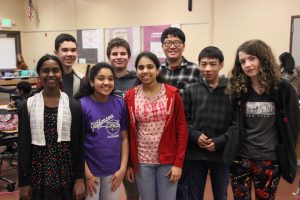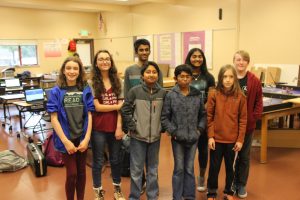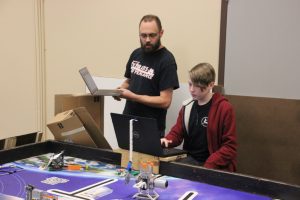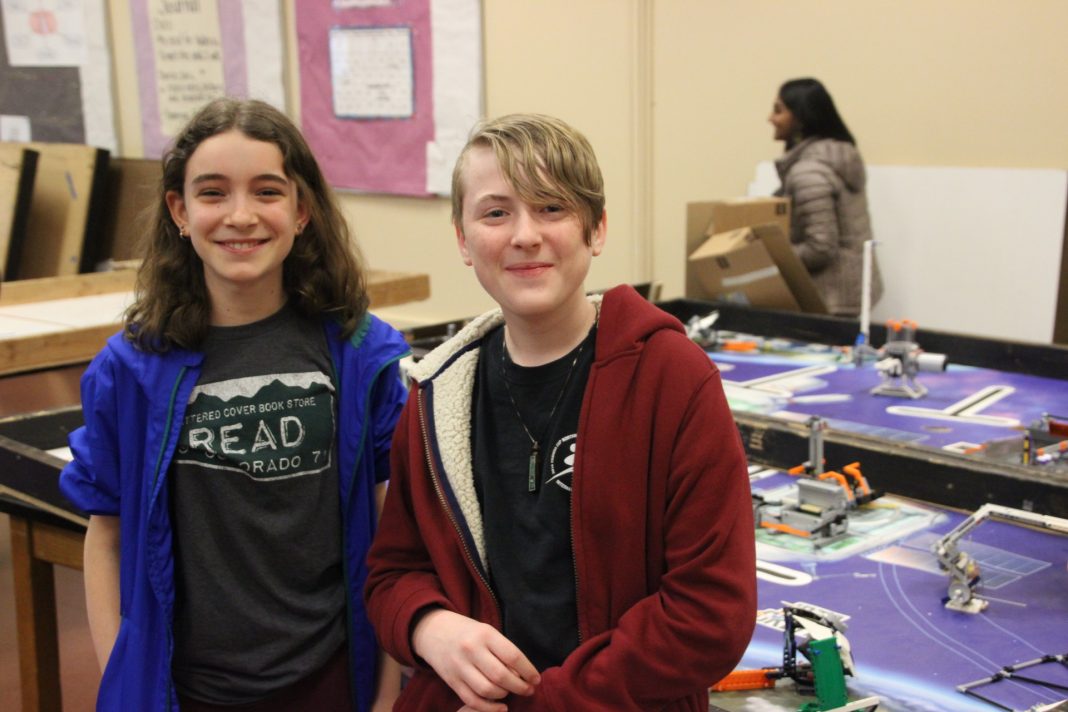It’s always a treasured moment, one John Chernoff sees over and over again.
As his 18 students at Jefferson Middle School work on an after-school science project, as they doodle with math, as they work on a presentation, as they work with robots, they’re smiling. They’re having a fun time.
 “I love it,” said Will Livingston, an eighth grader at Jefferson and a three-year participant in robotics. “It’s lots of fun.”
“I love it,” said Will Livingston, an eighth grader at Jefferson and a three-year participant in robotics. “It’s lots of fun.”
Math and fun. It’s not a common equation. But at Jefferson’s robotics project it is. That’s why they’re so good at it. For the past eight years, Jefferson has qualified for the state tournament. And Jefferson, one of the first schools in the state that started a robotics program, will likely be competing at the state tournament again in Kent on February 10 for its ninth straight trip to state.
“The kids have a good time,” Chernoff said. “They really enjoy it.”
Xyoa Wilding, a seventh grader on Jefferson’s robotics team, is drawn by the teamwork.
“I like feeling part of something,” she said. “It’s really fun. I want to be in a scientific field, so it’s a good starter thing.”
Robotics is a hands-on project that meets twice a week after school for a couple of hours. It’s designed to grow students into creators of technology and not just be consumers of technology. But Chernoff knows that not all of his students will become engineers.

“However, they will be adults who will have to be able to get along and do things,” Chernoff said. “While this gives them a good background in robotics and math and science and engineering, not all of them are going to choose those careers. But they still gain lots of benefits out of this program for the rest of their lives.”
In addition to gaining an insight to solving math and figuring out science problems, they’ll also learn important life skills – teamwork and cooperation.
“It’s something that will help them for their entire lives,” Chernoff said.
Robotics competition is a three-pronged event. In addition to designing and programing a robot, there’s also the challenge of putting together a presentation that addresses a specific question. This year’s question to answer involves going into orbit.
“So it’s a space-related problem,” Chernoff said. “They have to solve a problem related to space.”
It might be related to deep space travel. It might be living in outer space. It might be energy related. Materials related. Food related. Health related. They have to research their solution and they have to provide lots of information on how much it might cost, if it will it work, and if it is practical.
“They really get pretty in depth and then present this to the judges as well,” Chernoff said. “Judges are always interested in how they got to the solution, how they worked together on the solution.”

Many teams choose to do a skit as part of their presentation. Or they build a model or sing a song. They have a lot of creativity in how they present their project to the judges. The Jefferson teams tend to do a script and do a presentation that way. But all teams have a freedom on how they can creatively present. That’s part of the judging.
“Did one person stand and talk and present the whole thing,” Chernoff said. “They’d really like to see every person speak a little.”
The competition works in three ways. The students are judged on their core values: their cooperation, their teamwork, and how well they’re getting along with each other. And they’re judged on how they present their project, how they get along, and how their robots work.
“A judge is walking through the whole area noticing the team and writing down notes on those things,” Chernoff said. “So, it’s not just the presentation. It’s also the actual practice of the core values.”
They’re judged on their ability to work together and how they’re able to communicate and get along with each other. So, the competition isn’t just what a team’s robot can do. But that’s a big part of it. Teams have two and a half minutes for their robot to move automatically (without manual controls) through the assigned project.
Jefferson’s team project is based around radiation. They came up with an idea on how to build a suit to block radiation. Their project and solution is a multi-layered suit that absorbs a different kind of radiation. There’s a nuclear power plant aboard their craft that’s going to have radiation.
“It’s all about protecting space travelers or astronauts from radiation,” Chernoff said.
Jefferson’s other team’s solution deals with the health and stress management and coping with flying in outer space. They used a panda robot to give astronauts an artificial companion animal rather than taking a dog to space with them. That’s the project Livingston’s and Wilding’s team is working on.

“We know that dogs and cats can provide stress relief, lower blood pressure,” Chernoff said. “Their idea is they can bring these robotic animals to space and it would have different modes. It could play games. It could cuddle and provide you that companionship of an animal.”
Students are encouraged to reach out to industry professionals related to their problem and ask questions. Students are also required to present their projects in their community. They present around their school and they also try to present at an Elk’s Club or the Rotary Club. They’re also encouraged to reach out to engineers, astronauts, and air plane mechanics.
“Just all kinds of people who have working careers that might be a part of that,” Chernoff said. “Boeing would be a big one. They meet with a lot of FFL teams or answer emails. Our students emailed NASA.”
Jefferson Middle School’s principal Mike Cimino said the school’s intentions are to let the students take ownership of the class. He wants the students to be the author of their own learning.
“We have teachers that allow the students to make mistakes and for them to then learn from their mistakes,” Cimino said. “So, it’s really a student-driven program with guidance. I think the most important thing is they learn to work together as a team.”
Cimino praised his school’s science department.
“We have a great science department here and the kids actually know how to go out and speak in public,” Cimino said. “It’s pretty intense. It’s not just playing with Legos and robots. That’s the hook to get them in. What they’re really learning is the teamwork, the collaboration, the research, the presentation, their speaking ability. All of that. They’re learning a lot.”
But besides the learning, besides getting the chance to work on a science project, there’s one more thing that Paul Lee, an eighth grader on the team, likes.
“The main thing is you get to be with your friends and you get to work together,” Lee said. “That’s one of the things I really like. And of course robotics is another thing as well. One of the things that makes everything lively and fun is watching all the things harmoniously snap together like a puzzle. That’s very satisfying in my eyes.”














































